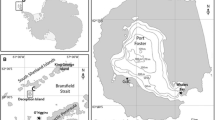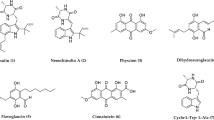Abstract
Extracts of 19 of 24 species of sponge collected from Queensland. Australia, inhibited the growth of test microorganisms in in-vitro assays. A similar result has been obtained by earlier workers for extracts of species of sponge obtained from temperate waters. Some of the extracts, including extracts of Thorecta vasiforis, Arenochalina mirabilis and Acanthella kleutha, showed activity against bacterial strains that was comparable with that exhibited by penicillin G and streptomycin against these strains. Gram-positive bacteria were expecially sensitive to many extracts. Little activity was exhibited by any extract against four species of fungi tested. Some of the extracts were markedly toxic to one or more of the test organisms (a fish, a crustacean and a hydroid) used, but no clear pattern linking toxicity to these organisms with antimicrobial properties of the extracts emerged. In general, there bas a negative correlation between antimicrobial activity and surface-fouling, raising the possibility of using freedom from surface-fouling as an indicator of antimicrobial activity. Four of five encrusting species from the undersides of coral boulders showed antimicrobial activity. This study confirmed the value of using methanol-toluene extracts in field-based screening programmes, but emphasised the need to use additional extracting media such as methylene chloride in order to augment the number of antimicrobial compounds detected. There are indications that antimicrobial activity may be widespread in the order Dictyoceratida, in the order Verongida and in the order Axinellida, but sporadic in other orders of Porifera.
Similar content being viewed by others
Literature cited
Acar, J. F.: The disc susceptibility test. In: Antibiotics in laboratory medicine, pp 24–54. Ed. by V. Lorian. Baltimore, London: Williams & Wilkins 1980
Amade, Ph., D. Pesando and L. Chevolot: Antimicrobial activities of marine sponges from French Polymesia and Brittany. Mar. Biol. 70, 223–228 (1982)
Baker, J. T. and V. Murphy: CRC handbook of marine science. Compounds from marine organisms, Vol. 1. 226 pp. Vol. 2. 223 pp. Cleveland: CRC Press 1976 and 1981 (Vols. 1 and 2. respectively)
Bakus, G. J.: Chemical defense mechanisms on the Great Barrir Reef, Australia. Science, N.Y. 211, 497–499 (1981)
Bergquist, P. R. and J. J. Bedford: The incidence of antibacterial activity in marine Demospongiae; systematic and geographical considerations. Mar. Biol. 46, 215–221 (1978)
Burkholder, P. R.: The ecology of marine antibiotics and coral reefs. In: Biology and geology of coral reefs, Vol. 2. pp 117–182. Ed. by O. A. Jones and R. Endean. New York, London: Academic Press 1973
Burkholder, P. R. and K. Ruetzler: Antimicrobial activity of some marine sponges. Nature, Lond. 222, 983–984 (1969)
Capon, R. J. and D. J. Faulkner: Antimicrobial metabolites from a Pacific sponge, Agelas sp. J. Am. chem. Soc. 106, 1819–1822 (1984)
Carte, B. and D. J. Faulkner: Polybrominated diphenyl ethers from Dysidea herbacea, Dysidea chlorea and Phyllospongia foliascens. Tetrahedron 37, 2335–2339 (1981)
Endean R. and A. M. Cameron: Toxins in coral reef organisms. In: Proceedings of the 7th world congress on animal, plant and microbial toxins. Toxicon 21 (Suppl. 3), 105–109 (1983)
Erickson, K. L. and R. J. Wells: New polychlorinated metabolites from a Barrier Reef collection of the sponge Dysidea herbacea. Aust. J. Chem. 35, 31–38 (1982)
Faulkner, D. J.: Interesting aspects of marine natural products chemistry. Tetrahedron 33, 1421–1443 (1977)
Faulkner, D. J.: Antibioties from marine organisms. In: Topics in antibiotic chemistry, Vol. 2. pp 9–58. Ed. by P. G. Sammes. Chichester: J. Wiley & Sons 1978
Green, G.: Ecology of toxicity in marine sponges. Mar. Biol. 40, 207–215 (1977)
Jackson, J. C. B. and L. Buss: Allelopathy and spatial competition among coral reef invertebrates. Proc. natn. Acad. Sci. U.S.A. 72, 5160–5163 (1975)
Kazlauskas, R., P. T. Murphy and R. J. Wells: A new sesquiterpene from the sponge Dysidea herbacea Tetrahedron Lett 49, 4949–4950 (1978)
Minale, L.: Natural products chemistry of the marine sponges. Pure appl. Chem. 48, 7–23 (1976)
Nakutsu, T., R. P. Walker, J. E. Thompson and D. J. Faulkner: Biologically active sterol sulphates from the marine sponge Toxadocia zumi. Experientia 39, 759–761 (1983)
Rinehart, K. L., Jr., P. D. Shaw, L. S. Shield, J. B. Gloer, G. C. Harbour, H. E. S. Koker, D. Samian, R. E. Schwartz, A. A. Tymiak, D. L. Weller, G. T. Carter, H. H. G. Munroe, R. G. Hughes, Jr., R. E. Renis, E. B. Swyenberg, D. A. Stringfellow, J. H. Vavra, J. H. Coates, G. E. Zurenko, S. L. Kuentzel, L. H. Li, G. J. Bakus, R. C. Brusca, L. L. Craft, D. N. Young and J. L. Connor: Marine natural products as a source of antiviral, antimicrobial and antineoplastic agents. Pure appl. Chem 53, 795–819 (1981)
Schmitz, F. J., R. S. Prasad, Y. Gopichaud, M. B. Hossain and D. van der Helm: Acanthifolicin, a new episulphide-containing polyether carboxylic acid from extracts of the marine sponge Pandoros acanthifolium. J. am. chem. Soc. 103, 2467–2468 (1981)
Shield, L. S. and K. L. Rinehart, Jr.: Marine-derived antibiotics. In: Antibiotics, isolation, separation and purification, pp 309–385. Ed. by M. H. Weinstein and G. H. Wagman. Amsterdam: Elsevier 1978
Sullivan, B., P. Djura, D. E. McIntyre and D. J. Faulkner: Antimicrobial constituents of the sponge Siphonodictyon coralliphagum. Tetrahedron 37, 979–982 (1981)
Tachibana, K., P. J. Scheuer, Y. Tuskitani, D. Van Engen, J. Clardy, Y. Gopichand and F. J. Schmitz: Okadaic acid, a cytotoxic polyether from two marine sponges of the genus Halichondria. J. Am. chem. Soc. 103, 2469–2471 (1981)
Wells, R. J.: New metabolites from Australian marine sponges. Pure appl. Chem. 51, 1829–1846 (1979)
Author information
Authors and Affiliations
Additional information
Communicated by G. F. Humphrey, Sydney
Rights and permissions
About this article
Cite this article
McCaffrey, E.J., Endean, R. Antimicrobial activity of tropical and subtropical sponges. Mar. Biol. 89, 1–8 (1985). https://doi.org/10.1007/BF00392871
Accepted:
Issue Date:
DOI: https://doi.org/10.1007/BF00392871




